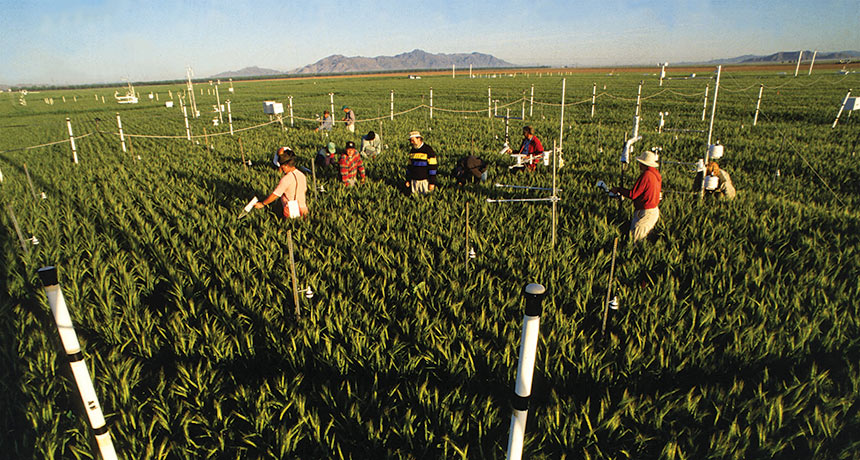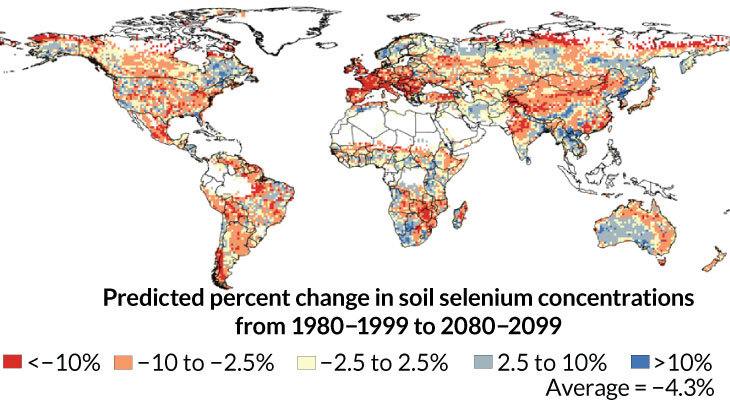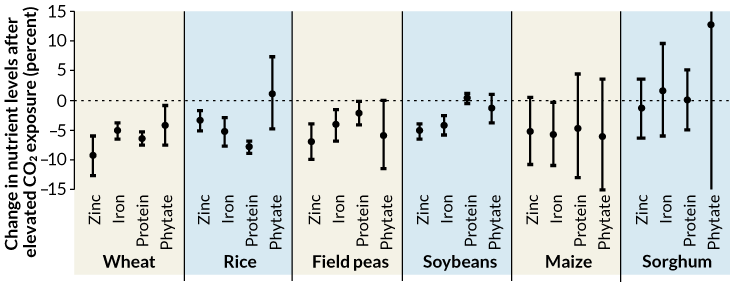Changing climate could worsen foods’ nutrition
Evidence builds for lessening of certain micronutrients, protein in plants

CROP FUTURES Experiments using circles of white pipes blowing extra carbon dioxide over crops suggest that certain nutrients may dwindle in crops grown in a carbon-enhanced future atmosphere. Here, researchers in Arizona measure the growth of wheat.
Jack Dykinga/USDA, Flickr (CC BY 2.0)
A dinner plate piled high with food from plants might not deliver the same nutrition toward the end of this century as it does today. Climate change could shrink the mineral and protein content of wheat, rice and other staple crops, mounting evidence suggests.
Selenium, a trace element essential for human health, already falls short in diets of one in seven people worldwide. Studies link low selenium with such troubles as weak immune systems and cognitive decline. And in severely selenium-starved spots in China, children’s bones don’t grow to normal size or shape. This vital element could become sparser in soils of major agricultural regions as the climate changes, an international research group announced online February 21 in Proceedings of the National Academy of Sciences.
Likewise, zinc and iron deficiencies could grow as micronutrients dwindle in major crops worldwide, Harvard University colleagues Samuel Myers and Peter Huybers and collaborators warned in a paper published online January 6 in the Annual Review of Public Health. Futuristic field experiments on wheat and other major crops predict that more people will slip into nutritional deficits late in this century because of dips in protein content, Myers reported February 16 at the Climate and Health Meeting held in Atlanta.
“If we’d sat down 10 years ago and tried to think what the effects of anthropogenic carbon dioxide emissions might be on human health, none of us would have anticipated that one effect would be to make our food less nutritious,” Myers said. “But we can’t fundamentally disrupt and reconfigure most of the natural systems around our planet without encountering unintended consequences.”
Figuring out those unintended nutrient consequences isn’t easy. For selenium, scientists have only a rough idea of the element’s global movements. It’s unclear what proportions erode out of rocks or waft onto land from sea, says biogeochemist Lenny Winkel of ETH Zurich and the Swiss aquatic research group Eawag in Dübendorf. She was the principal investigator for the selenium in soils project in the new Proceedings paper. As far as she knows, it presents the first global look at selenium concentrations in soils and what basic factors influence what’s there. This scale, she says, was “a bit bold.”
Starting with more than 33,000 data points from other sources, Winkel and colleagues pieced together a map of selenium concentrations in soils across much of the globe. Climate popped out as one of the more important predictors of selenium content in soil, a link that hadn’t shown up in small studies. Places where climate turns land arid generally have lower selenium, but soil character matters, too. Places with high organic carbon, as in a woodland rich with fallen leaves, as well as places with abundant clay, tend to do better at retaining selenium.
Story continues after map
Selenium slump
Soil concentrations of the element selenium, essential for human life, could change by the end of the 21st century, according to computer simulations based on an intermediate scenario for climate change (a scenario that the Intergovernmental Panel on Climate Change labels RCP6.0). The analysis identified what influences soil selenium now — including precipitation and concentrations of organic carbon in soil — and predicted future concentrations based on those influences.

By the end of the century, about two-thirds of heavily cultivated agricultural land would probably lose selenium under an intermediate scenario of climate change, Winkel and colleagues conclude. With a projected average end-century warming of 2.2 degrees Celsius compared with 1986 to 2005, selenium drops in breadbasket regions in the study by an average of 8.7 percent. Only 19 percent of croplands seem likely to gain selenium.
The new map “is worrisome,” says plant physiologist Philip White of the James Hutton Institute in Invergowrie, Scotland. White, who studies agricultural plants, has published on selenium but was not part of the new study. As a rule of thumb, he says, natural selenium concentrations in soil “are directly related to the selenium available in plants.”
That may be a rule of thumb. But Winkel says that to refine predictions, scientists need to consider how plant species vary in building up selenium in their tissues. Brazil nuts, for instance, accumulate so much selenium that extreme and persistent fans can develop signs of overdosing. One sign of excess: otherwise unexplained garlic breath.
Excess can be an issue because the healthful ranges of selenium are narrow. “You can quickly get too much or too little,” Winkel says. This Goldilocks problem complicates planning for what to do about shortages: What boosts health among the nutrient-poor might not be so good for well-fed people with varied sources of selenium.
Zinc and iron concentrations in crops, too, will probably shift as climate changes, Myers and colleagues reported in Nature in 2014. They analyzed harvest samples from a total of 41 cultivated varieties of major crops (wheat, rice, field peas, soybeans, maize and sorghum) grown with the expensive and elaborate experimental protocol known as FACE, for Free-Air CO2 Enrichment. In Australia, Japan and the United States, test crops grew in outdoor fields within futuristic Stonehenge circles of skinny ducts blowing extra carbon dioxide to mimic mid- to late-century atmospheres. Sites varied, but at the time, researchers reported their baseline CO2 as 363 to 386 parts per million and pushed their pipes to deliver 546 to 586 ppm.
Story continues after graph
Nutrient drop
Multiple varieties of major crops showed some nutrient changes when grown outdoors with extra carbon dioxide blown over them (ranging from 546 to 586 ppm) in seven spots scattered across Australia, Japan and the United States. Sorghum and maize, plants capturing carbon with what’s called a C4 pathway, may be better at preserving nutrients in a future carbon-enriched atmosphere than most crops. Phytate, not a nutrient but a compound that can sabotage zinc uptake in humans, decreased only in wheat. The phytate dip might help compensate for declining zinc, but researchers note that zinc decreased even more than phytate content did. Just what these declines mean depends on how many people draw a substantial part of particular nutrients from a particular crop, a calculation later papers are starting to address.

Based on samples from these far-flung experiments, the researchers found iron concentrations in wheat dropped an average of 5 percent. Zinc levels fell 9 percent. Most other crops showed a tendency toward declines too, although maize and sorghum, which use what’s called the C4 pathway for carbon capture, showed signs of possible resilience.
Then Myers asked: “So what?”
Figuring that out wasn’t easy. A major plant source of the minerals for Ethiopia might not matter much for England with its meat-rich diet. Myers and colleagues put together an epic database of how much of 95 foods people eat in 188 countries around the world, and then calculated where the relatively modest downturns of zinc would put people at risk in the future. Nutrient changes by 2050 would push about 138 million more people into zinc deficiency, the researchers reported in 2015. And for more than 2 billion people already zinc deficient, future crop declines could make their health problems even worse.
The shortfall could be especially hard on women and children. Too little zinc raises pregnant women’s risks of premature delivery and can doom children to poor weight gain and growth. A robust immune system needs adequate zinc, and public health specialists blame 100,000 child deaths a year on immune responses so enfeebled by skimpy zinc that children couldn’t fight off pneumonia or diarrhea.
Livestock also may have to contend with plant nutrition changes. There will be complex interactions among CO2, temperature and water, which we don’t fully understand yet, says Jerry Hatfield. He’s a plant physiologist at the U.S. Department of Agriculture’s National Laboratory for Agriculture and the Environment in Ames, Iowa. Some of the best evidence so far for effects of CO2 enhancement comes from FACE experiments in rangeland grasses, he says. Rising CO2 spurred rapid growth but weakened the grasses’ ability to take up nitrogen. Grass short on nitrogen didn’t have the raw materials for the usual protein content of livestock forage.
Just how the soaring CO2 lowers nutrient content remains under debate. The prevailing hypothesis has been that extra carbon in the atmosphere lets plants bulk up with carbohydrates, in a sense diluting anything that isn’t a carbohydrate, plant micronutrients included.
Not so, says plant physiologist Arnold Bloom of the University of California, Davis, a coauthor of the 2014 paper in Nature. A wide range of experimental results show that although most nutrients go down, some do not and some even go up. That doesn’t fit with a general pattern of low, “diluted” concentrations, concentrations of the various noncarbohydrates scattered all over the place.
With nutrient concentrations going down, it might seem that people could solve the problem just by eating more. But there may not be more. Early studies raised hopes that extra CO2 might give plants’ carbon-trapping machinery extra raw material for growth spurts and bonanza yields. But sustained growth now looks elusive. Experiments tracking growth over years suggest that plants may not sustain initial surges, and theoretical predictions that build in such nonminor details as pests and water supplies are not encouraging. The 2014 report from the Intergovernmental Panel on Climate Change notes that crop yields are more likely to decrease than soar and agriculture will have to change to try to compensate.
“Global demand for food is rising more steeply than ever before in human history,” Myers said in Atlanta. In 40 years, agriculture will have to produce 70 percent more food than it does today just to keep even as Earth’s population grows by several billion people. Yet in this time of growing need, human activities are transforming the climate in ways that could make farming even more of a challenge.






